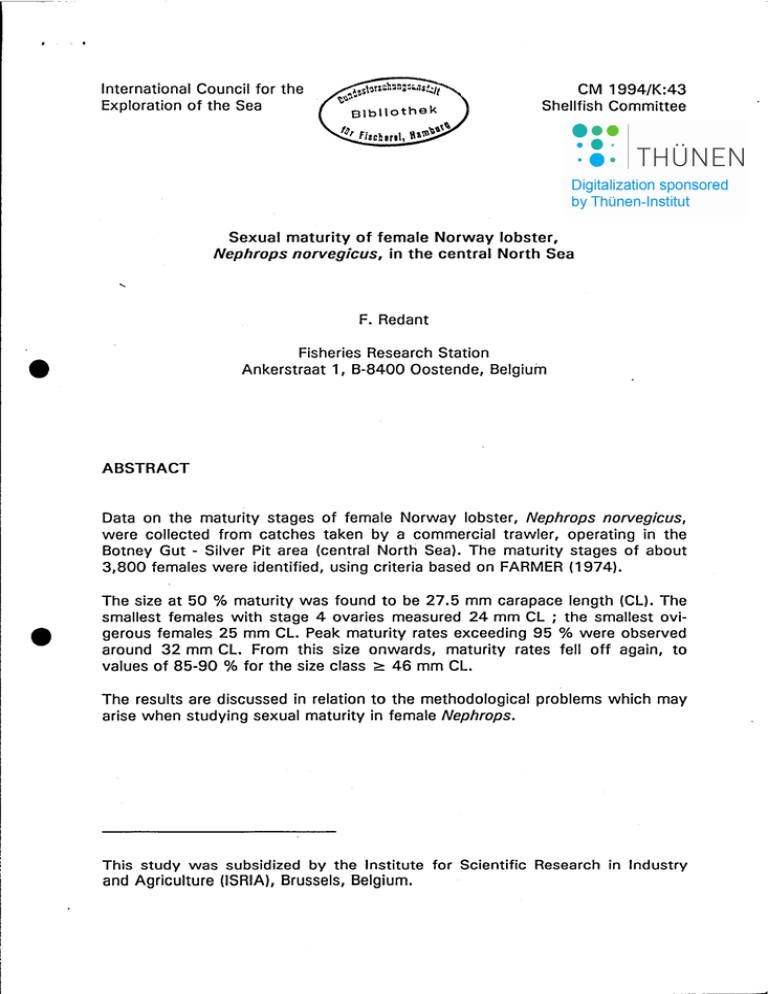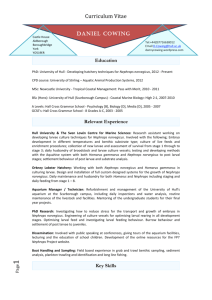
International Council for the
Exploration of the Sea
CM 1994/K:43
Shellfish Committee
Sexual maturity of female Norway lobster,
Nephrops norvegicus, in the central North Sea
F. Redant
Fisheries Research Station
Ankerstraat 1, B-8400 Oostende, Belgium
ABSTRACT
Data on the maturity stages of female Norway lobster, Nephrops norvegicus,
were collected from catches taken by a commercial trawler, operating in the
Botney Gut - Silver Pit area (central North Seal. The maturity stages of about
3,800 females were identified, using criteria based on FARMER (1974).
The size at 50 % maturity was found to be 27.5 mm carapace length (CL). The
smallest females with stage 4 ovaries measured 24 mm CL ; the smallest ovigerous females 25 mm CL. Peak maturity rates exceeding 95 % were observed
around 32 mm CL. From this size onwards, maturity rates fell off again, to
values of 85-90 % for the size class > 46 mm CL.
The results are discussed in relation to the methodological problems which may
arise when studying sexual maturity in female Nephrops.
This study was subsidized by the Institute for Scientific Research in Industry
and Agriculture (ISRIA), Brussels, Belgium.
- 2-
INTRODUCTION
For a number of years already the length based assessments on female Norway ,
lobster, Nephrops norvegicus, are being madewith separate growth curves for
immature and mature animals, the transition length between the two groups
being the size cit 50 % maturity (see e.9. ICES, 1994a). Detailed information on
female sexual maturity is also essential' when calculating e.g. the spawning
stock
I
... biomass or the reproductive potential of Nephrops stocks.
The aim of the present study, carried out in the margin of a research programme on gear selection and discarding in the Belgian Nephrops fish'ery, was
to collect data on female sexual maturity in the Botney Gut - Silver Pit stock
(central North Seal, and to provide estimates of the sizes at first and i at 50 %
matui"itY.
MATERIALS and METHODS
Data on the maturity stages of female Nephrops were collected on 7 and
8 September 1993, from catches taken by a commercial Nephrops trawler
'.. operating in the Botney Gut - Silver Pit area; Sampies were coilected from two
'..' . hauls, viz. haut 56 (made on 7 September between 1.00 and 5.00 p.m.) and
haut 60 (made on 8 September betwesn 5.30 and 9.00 a.m.).
~.
Sampies of the largest size c1asses in the ,catches were taken after soriing of
'the catch by the ship's crew (see REDANT and POLET, 1994~ for further
information on the sorting process). Nephrops to t:>e landedwhole (mostly > 35
mm CL) and Nephrops to be tailed (mostly 30-40 mm CL) were sub-sampled,'
such that the fractions retained contained about, 1,000 and 200 females
respectively. The discards were sorted by the sCieniific crew, and then graded
into three size. categories, viz. ·,'small.... « 30 mm CL), "medium" (25-35 mm
CL) and "/arge" (> 30 mm CL). From these toD sut:>-samples were taken, as a '
rule containing 200-300 females each.
The numbers of females measured per sorting category (smalI, medium and
large discards, Nephrops to be tailed, and Nephrops to be landed whole), and
per mm size class are shown in Tables 1 and 2.
This "stratified" sampling method was preferred over sampling of the unsorted
catch, to make sure that. as wide a range of size c1asses as possible was
sampled in sufficient numbers,' to allow ttie, calculation of a maturity ogive
extending into both the smallest and the largest size classes in the population.
I
•
-3 -
After sorting, the females were measured tcarapaee length, CL, to the nearest
mm), and their rriaturity stage. was identified by external examination, usirig
critoria based on FARMER (1974) :
Empty
Maturing
Mature
'-
Ovigeraus
Hatching
•
no visible signs of ovary development (Farmer's stages 1
and 2).
ovary pale green, ,visible thraugh. the carapace, but not
exteriding irito the abdomEm (Farmer's stage 3).
,
ovary fully developed, dark green in colour and exteriding
into the abdomen (Farmer's stage 4).
.
with recenily spawned, dark green.eggs under the abdomen.
with eggs close to hatching, cr with remnants of receritlY
hatched eggs under the abdomen.
For severai reasons (time constraints, ,the necessity to leav'e the animals intact,
ete.), it was impossible to examine other indicators of. sexual maturity, sueh as
ovary weight, developmerital stage of the oocytes or the presence of spermatophores.
To caiculate the proportions of ·female:> by maturity stage, the observed
mimbers-at-Iength in each sorting category were first raised to total m.imbers-atlength in the lmsorted eatch. The relative proportions of each matui"ity stage
were then obtained by dividing the raised numbers-at-Ierigth for each stage by
the total riumbers-at-Iength of the females in the unsorted catch.
•
This method was preferred over straightforward summing across cätegorios,
mainly because fishermen's selection was found to be highly dependent on the
maturity. stage of the females (see REDÄNT and POLET, J 994, for further
information on fishermen's selection and discarding). Many mature arid
ovigerous females in particularly the middle range of the size distribution are
either tailed or discarded, and therefore their relative numbers varied substantially fram one sorting category to another.
RESULTS
.
\
The curriuiatod relative proportions of the maturity stages by sizo class are
shown in Figures 1 and 2, for hauls 56 and 60 respeciively.
In general, the graphs in Figures 1 and 2 are very similar, the main difference
being a marked inCrl3aSe in the proportion cif ovigerous females in almost all size
classes; from haul 56 to hauI 60. 11: is tempting to rE~late this increase to the
time lapse bctween the two hauls~ and to expiain it as ci rosult cf thc ongoing
spawning activity. It should, however, be noted that the two hauls ware made
- 4-
in different parts of the Botncy Gut - Silver Pit area, and therefore, that the
difference may be just geographical.
I
The maturity ogives are shown in Figures 3 and 4, for hauls 56 and 60 respectively. The percentages of "mature" females in these graphs were obtained by
summing the relative proportions of maturing, mature and ovigerous females in
each size class. Thus, they should be seen as an estirT18te of the proportions of
females which (may) take part in the ongoing spawning season~ rather than as
an estimate of the actual proportions· of fully mature females at the': time of
sampling. The curves were plotted by means of
maximum likelihood routine
for the left, more or less sigmoid part of the curve, and by calculation o~ a trend
line for the right, linear part of the curve.
'
a
The overall shape of the two curves is very similar, and the lengths at 50 %
maturity (viz. 27.3 and 27.4 mm CL) are almost identical.
•
.The smaliest female with fully mature gonads (Farmer's stage 4) measured
24 mm CL (in both hauls) ; the smallest ovigerous female 25 mm CL (in both
!
hauls).
'~l'\"
..
;':rhe
graphs show two remarkable features:
,.'
'
~
~
'(al
even in the middle part of the size range (30-35 mm CL), where the
highest maturity rates are found, none of the size classes shows 100 %
maturity rate; and
(b)
from a size of about 32 mm CL, the matui"ity rates fall off almost linearly,
to a value of 85-90 % for the size class > 46 mm CL.
a
•
DISCUSSION
The choice of the period for collecting data on female sexual maturity in
Nephrops is very important. If the measurements are made too early in tlle year
(i.e. long before the onset of the spawning period), considerable proportions of
the females weil above the size at 50 % maturity may still be "empty", and this
would result in an over-estimatiori of the size at 50 % maturity (DIAZ in ICES,
1994b).
'
,
. If, on the other hand, the measurements
are made too,
late
in theyear' (e.g.
at
."
.
.
the peak of the spawning season or later), large proportions of the ovigerous
females will be missed in the s~HTlples, mainly because, owing to their: burrowing behaviour, ovigerous females are much less accessible to trawling. This
~
5 -
wouid aga in result in an. over-estimätiori of ihe size at 50 % matudty (MORIZUR, 1979 ; DIAZ in ICES, 1994b).'
In the Botney Gut - Silver Pit area, spawning usually takes place in SeptemberNovember (Figure5, taken trom STERK and REDANT, 1989, and corripleted
with ihe data tor 1989-93). Since the sampies for this study were taken eady in
Soptomber (Le. at the very beginning of the spawning season), the problems of
fomales notyet being mature, or of 'ovigerous temales already havirig disapeeared in the burrows, were largely avoided;
.
,
In provious studios on the sexual maturity of female Nephrops, several criteria
have boen tised to define the size at 50 % maturity, such as the proportions of
ovigerous females; ihe general appearance of the gonads (shape, colour, etc.),
their voiume or weight, the developmental stage of the oocytes, the presence
of a spermatophore in the thelycum, or a combination of several of these criieda (see e.g. FIGUEIREDO and THOMAS, 1967 ; FARMER, 1974 ; HILUS,
1976,; MORIZUR, 1979 ; BAILEY, 1984 ; BRIGGS, 1988 ; FIGUEIREDO iri ICES,
1994b).
Unless spawning is concentrated within a very. short period of time - which, in
most Nephrops stocks, is not the case - the ovigerous condition of the females
seems to be ihe least reliable criterion to determine the size at 50 % maturity.
By the time the "Iate spawners" appear in the sampies, the "Selrly spawners"
will have disappeared in their burrows, which makes them' inaccessible io
sampling. This may result iri a substantial under-estimation of the proportions of
ovigerous females, and in an equally substantial over-estimation of the size at
50 % maturity.
•
Methods, such as the one used in thls study, which are based on a comhination
of ovary stage (to identify those females which are. Iikely to spawn within the
next few weeks or months), and ovigerous condition, give a much closer
approximation of the size at 50 % maturity.
It should, however, be noted that not all females with ovaries in stage 3
(maturing), arid maybe even stage 4 (mature), will eventually spawn within Üie
next few months. Whether spawning can be successfully completed cr not,
depends on both ovary development and the presencc of a spermatophore in
the thelycum (FARMER; 1975). The Gombined use of these two criteda gives
maturlty ogives which aresHghtlY shifted to ihe right as compared to those
otltained trom ovary stages. only, but the resulting differences in the sizes at
50 % maturity are very small (MORIZUR, 1979 ; BAILEY, 1984).
The size at, 50 % maturity, of temale Nephrops iri. the Botney Gut - Silver Pit
area (vii. 27.5 mm CL) is slightly higher than tl1e sizes reported tor most other
stocks iri the ICES area (Table 3). Recent studies in the Clyde (West Scotlarid)
ha"e shown, however, that biological param(üers such as groWth rates and size
-6I
II
\
at 50 % m'aturity, can vary considerablyon a small geographical scale (TUCK et
al. in ICES, 1994b). Femalesiies at 50 % maturity, derived trom sampIes taken
on 6 different locations within the Clyde, ranged trom 23 to 30 m~ CL, Le.
a range comparable to the one seen in the data for all Nephrops stocks in the
NW European waters (Table 3).
I
Jff
The fact that, trom a size of about 32 mm CL, the maturity rates fall
again,
once more confirms the existence of a biennial spawning regime in 'northern
Nephrops stocks (SYMONDS, 1972 ; BAILEY, 1984 ; REDANT, 1987 '; STERK
and REDANT, 1989). Bearing in mind that part of the larger temales with stage
3, and maybe even stage 4 ovaries, may not spawn, and eventually will resorb
their ovaries (FIGUEIREDO, 1982), it cannot be excluded that the actual propor- '
tions of temales skipping a spawning period may be larger than suggested by
the maturity ogives.
.
•
LITERATURE CITED
,..
.....
':BAILEY, N. (1984) : Some aspects of reproduction in Nephrops.
·:lCES, Shellfish Comm., CM 1984/K:33 (mimeo).
'~~RIGGS,
I
R. (1988) : A preliminary analysis of maturity data for NorthJest Irish
"Sea Nephrops.
ICES, Shellfish Comm., CM 1988/K:21 (mimeo).
FARMER, A.S.D. (1974): Reproduction in Nephrops norvegicus (Decapoda
1
Nephropidae) .
~J. Zool., London, 174, 161-163.
l
i
FARMER, A.S.D. (1975) : Synopsis of biological data on the
Nephrops norvegicus (Linnaeus, 1758).
FAO Fisheries Synopsis, No. 112, 1-97.
;
Norway ilobster,
I
1
I
FIGUEIREDO, M. (1982): The occurrence of resorption in the ovaries of
Nephrops norvegicus (L.) in Portuguese waters.
ICES; Shellfish Comm., CM 1982/K:28 (mimeo).
FIGUEIREDO, M. and THOMAS, H.J. (1967) : On the biology of the Norway
lobster, Nephrops norvegicus (L.).
J. Cons. Int. Explor. Mer., ~ (1), 89-101.
HILUS, J.P. (1979) : Growth studies on the prawn Nephrops norvegicus.
Rapp. Proc.-verb. Reun. Cons. Int. Explor. Mer, llli, 170-175.
;
•
-7-
ICES (1994a) : Report of the Working Group on the assessment of Nephrops
and Pandalus stocks.
ICES, CM 1994/Assess: 12 (mimeo).
ICES (1994b) : Report of the Study Group on Nephrops stocks.
ICES, Shellfish Comm., CM 1994/K:9 (mimeo).
MORIZUR, Y. (1979) : Utilisation de criteres fonctionnels (presence de spermatophore, maturation des ovaires) pour la determination de la taille et I'age a
maturite sexuelle de Nephrops norvegicus femelIes dans la region Sud-Bretagne.
ICES, Shellfish Comm., CM 1979/K:41 (mimeo).
•
REDANT, F. (1987): Reproduction and seasonal behaviour of the. Norway
lobster, Nephrops norvegicus, in the Central North Sea .
ICES, Shellfish Comm., CM 1987/K:32 (mimeo).
REDANT, F. and POLET, H. (1994) : Results of a discard study on the Belgian
Nephrops fishery in the central North Sea.
ICES, Shellfish Comm., C.M. 1994/K:44 (mimeo).
STERK, W. and REDANT, F. (1989) : Further evidence on biennial spawning of
the Norway lobster, Nephrops norvegicus, in the Central North Sea.
ICES, Shellfish Comm., CM 1989/K:2 (mimeo).
SYMONDS, D.J. (1972) : The fishery for the Norway lobster, Nephrops norvegicus, off the north-east coast of England .
Fish. Invest. (London), Series 2, 27, 1-35 .
•
-8-
.
fractions samp1ed (FS) and numbers of
Tab1e 1 - Hau1 56
fema1es measured per category and per mm CL
CL
Discards
sma11
Discards
medium
Discards
1arge
Landings
tai1s
Landings
who1e
FS = 1:2
FS = 1:4
FS = 1:2
FS = 1:1
FS = 1:1
<21
,21
22
23
24
25
26
27
28
29
30
31
32
33
34
35
36
37
38
39
40
41
42
43
44
45
>45
13
4
4
16
43
64
73
40
25
6
Tot
288
1
2
1
13
15
22
31
36
36
31
36
13
6
1-
1
1
1
2
8
12
7
30
27
87
84
105
107
85
104
76
75
84
70
50
41
56
25
46
100
1,181
2
5
15
21
21
11
6
9
2
3
3
-1
-
246
Total no. of measurements
1,815
Raised to nos. in unsorted catch
2,941
•
•
-9-
.
fractions sampled (FS) and numbers of
Table 2 - Haul 60
females measured per category and per mm CL
Discards
small
CL
•
FS
=
1:1
<21
'21
22
23
24
25
26
27
28
29
30
31
32
33
34
35
36
37
38
39
40
41
42
43
44
45
>45
28
11
9
14
32
49
57
70
29
5
Tot
304
Discards
medium
FS
=
1:2
1
4
19
38
58
40
30
24
7
7
2
Discards
large
FS
=
1:1
1
1
13
31
38
33
23
23
15
11
14
5
4
1
1
2
1
1
232
217
-1
-
Landings
tails
FS
=
Landings
whole
1:6
FS
1
1
6
10
8
10
35
39
36
31
13
20
13
6
1
1
=
1:2
1
-2
8
8
8
12
22
41
64
65
114
102
102
124
81
84
63
36
58
995
231
Total no. of measurements
1,979
Raised to nos. in unsorted catch
4,361
I
I
I
I
l
- 10 -
Table 3 - Sizes at 50 % maturity (in mm CL) of female
Nephrops in NW European waters (*)
size 50 %
maturity
Area
criteria used
Reference
:
Skagerrak
and Kattegat
28.0
Ovary stage +
ovigerous
Ulmestrand,
pers. comm ..
Clyde
27.0
27.0
Ovary stage
Ovary stage +
spermatophore
Bailey, 1984
Ovary stage
Tuck, et al.,
in lCES, 1994b
Ovary stage
Bailey, 1984
Ovary stage +
ovigerous
Hillis, 1979
Ovary stage +
ovigerous
Briggs, 1988
Clyde
23.0-30.0
Sound of Jura
W lrish Sea
NW lrish Sea
23.0
25.0-26.0
23.5
Bay of Biscay
data for 1977
23.0-23.5
23.5-24.0
24.0
Spermatophore
Ovary stage
Ovary stage +
spermatophore
Morizur, 1979
Bay of Biscay
data for 1978
22.0-22.5
23.0
23.0
Spermatophore
Ovary stage
Ovary stage +
spermatophore
Morizur, 1979
SW Portugal
30.0
Ovary stage +
ovigerous
Figueiredo,
in lCES, 1994b
Botney Gut
27.5
Ovary stage +
ovigerous
This study
(*)
sizes at 50 % maturity derived from the proportions of
ovigerous females only, are not included in this table
(see text, Discussion section).
•
•
Nephrops : Female sexual maturity
Maturity stages by size class : Haul 56
Percentage of total
100% . - - - - - - - - - - - - - - - -
-
_
--
Hatchlng
0
0
80%
Empty
Maturlng
Mature
Ovigerous
60%
40%
20%
0% I---'--"--"='
(. 20
25
30
35
40
45
Length class (mm CL)
Figure 1
Nephrops : Female sexual maturity
Maturity stages by size class : Haul 60
Percentage of total
100%
.------------------~_~_...
--
Hatching
0
D
80%
•
Empty
Maturlng
Mature
Ovlgerous
60%
40%
20%
25
30
35
Length class (mm CL)
Figure 2
40
45
Nephrops: Female sexual maturity
Maturity ogive : Haul 56
% Mature
100%
o
80%
60%
40%
20%
o%G3-e---e-~-l--t--'----l....I---'-----'---+----'-----'-----'----l.-+--l--'--'--'--f--'-----'----.l..-...L.--+----J
co
20
25
30
35
Length class (mm cL)
40
45
Figure 3
Nephrops : Female sexual maturity
Maturity ogive : Haul 60
% Mature
100%
o
o
000
80%
•
60%
40%
....
I\)
20%
~
3
3
0% G3-e--fl--B"':.I...-t--'--'-L.L---'---+----'-----'-----'-----'--+--l--'--''--'--f--'-----'----.l..-.l..--+----J
(- 20
25
30
35
40
45
Length cl ass (mm CL)
Figure 4
t
•
Nephrops : Reproduction cycle
Monthly percentages of ovigerous females
% Ovigerous of ali females ,- 36 mm CL
100% r - - - - - - - - - - - - - - - - - . - - - - - - - - - - - - ,
80%
60%
40% 1-
.
20%
0%
Jan
I
Figure 5
•
Jan
86
I
Jan
Jan
87
I
88
I
Jan
Jan
89
I 90 I 91
Year and month
Jan
I
Jan
92
I
93





